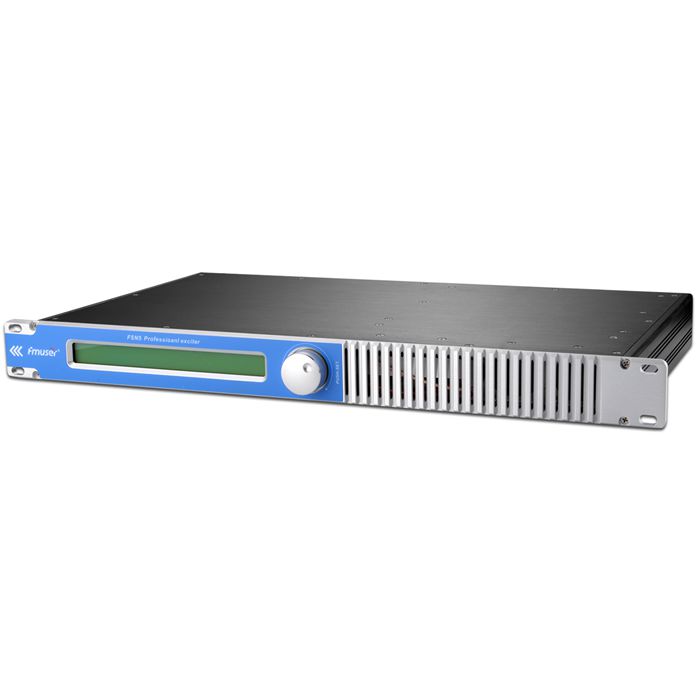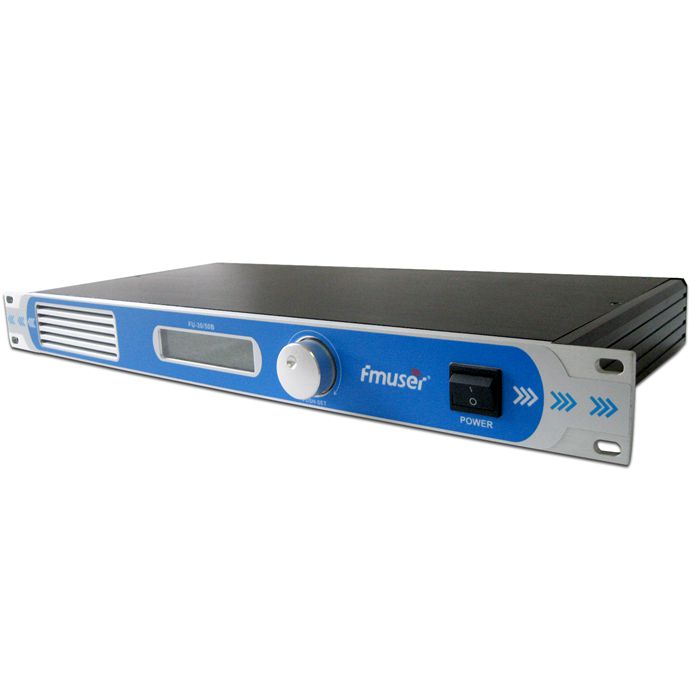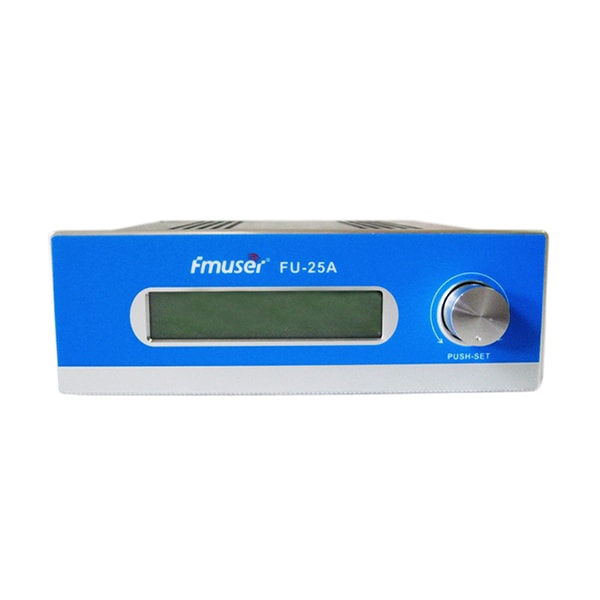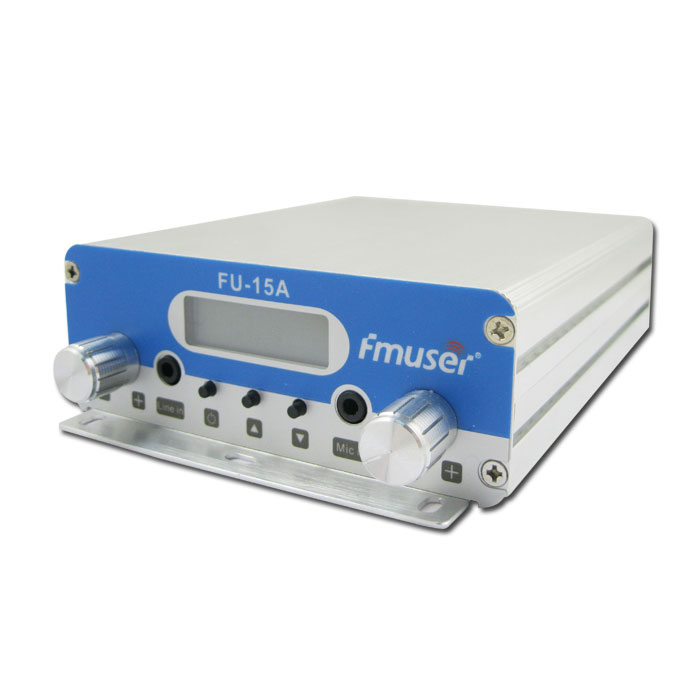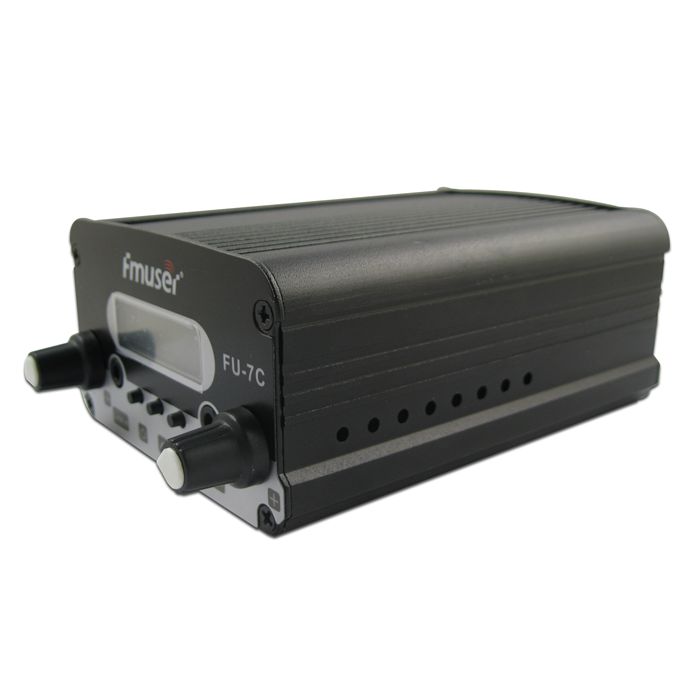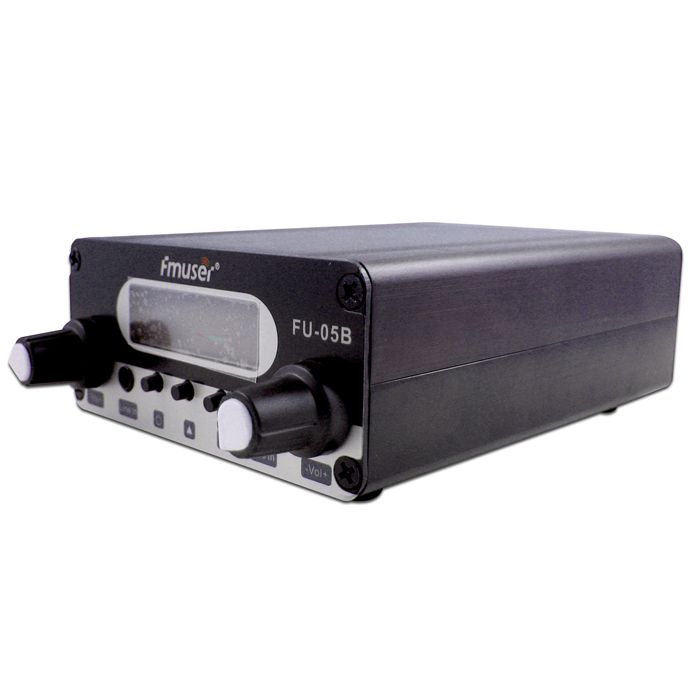
Low Power FM Transmitters
Low Power FM Transmitters are critical tools for delivering crisp, reliable audio across industries like community radio, educational campuses, event broadcasting, religious institutions, and retail environments.
1. Powering Your Voice, Simplifying Your Choice
At FMUSER, we specialize in high-performance, FCC-certified transmitters designed to cater to diverse broadcasting needs. This page organizes our solutions by power output, frequency range, and use-case compatibility, helping professionals quickly identify systems tailored for small-scale projects or large commercial operations. Whether you’re upgrading existing infrastructure or launching a new station, our classifications ensure clarity and confidence in every choice.
2. Key Features: Engineered for Excellence, Built for Impact
FMUSER’s transmitters stand out with military-grade durability, 90%+ energy efficiency, and global certifications (FCC, CE). Advanced features such as digital signal processing (DSP), automatic frequency control (AFC), and Bluetooth integration ensure interference-free transmission. Our scalable lineup covers:
- Entry-Level (1W–15W): Perfect for hobbyists or small venues.
- Mid-Range (20W–50W): Ideal for schools and houses of worship.
- Industrial-Grade (60W–100W+): Built for airports, malls, and large events.
Every system is pre-configured for plug-and-play operation, reducing setup time and technical hassles.
3. Diverse Applications: Transform Your Reach with FMUSER
Explore how our Low Power FM Transmitters empower industries to deliver crystal-clear audio, streamline operations, and engage audiences effectively:
1) Community Radio Stations
Low Power FM Transmitters are the backbone of grassroots broadcasting, enabling local stations to share news, music, and cultural programming within neighborhoods. FMUSER’s solutions excel here with FCC-certified transmitters (10W–50W) that combine plug-and-play simplicity with robust signal reliability. Our compact designs allow stations to set up quickly, even in limited spaces, while advanced noise reduction ensures interference-free broadcasts. For budget-conscious operators, FMUSER offers pre-configured transmitter packages with antennas and cabling, minimizing downtime and technical hurdles.
2) Educational & Campus Radio Networks
Schools and universities leverage FMUSER’s transmitters to create dedicated radio channels for announcements, lectures, or student-led shows. Systems like our 20W–30W models deliver consistent coverage across sprawling campuses, with user-friendly interfaces ideal for non-technical staff. Teachers can broadcast educational content to parking lots or outdoor areas, while administrators use our Bluetooth-enabled transmitters to stream emergency alerts. FMUSER’s IP65-rated outdoor enclosures further ensure year-round durability, even in harsh weather.
3) Events, Drive-Ins & Live Entertainment
From drive-in theaters to music festivals, temporary events demand portable yet powerful audio solutions. FMUSER’s rugged, lightweight transmitters (15W–50W) provide interference-free synchronization between screens and speakers, eliminating lag in open-air venues. Features like dual-frequency switching help avoid channel clashes in crowded RF environments, while our instant-on designs let event planners go live in minutes. For multi-day festivals, FMUSER’s energy-efficient transmitters reduce power costs by up to 40% compared to traditional setups.
4) Retail, Hospitality & Background Broadcasting
Retailers, hotels, and restaurants rely on FMUSER to deliver background music, promotions, or guided tours via in-building FM systems. Our low-power 1W–10W transmitters blend seamlessly into existing audio infrastructure, with RCA/3.5mm inputs for connecting playlists or PA systems. In large malls, FMUSER’s repeatable signal coverage ensures uniform audio quality across floors, while encrypted transmission modes prevent unauthorized access. For chains, our OEM customization lets brands integrate transmitters discreetly into decor, maintaining aesthetic appeal.
5. Buying Guide: Match Your Needs, Maximize ROI
- Technical Specs: Prioritize power (10W–100W), frequency range (87.5–108 MHz), and compatibility (RCA/XLR/Bluetooth inputs).
- Scalability: Start small and expand seamlessly with modular systems.
- Budget Planning: Entry-level kits from $199; enterprise solutions under $2,500.
-
![FMUSER FMT5.0-50H 50W FM Radio Broadcast Transmitter]()
FMUSER FMT5.0-50H 50W FM Radio Broadcast Transmitter
Price(USD):Ask for a quotation
Sold:2,179
FMT5.0-50H FM radio transmitter is highly reliable, lighter in weight, and easier to operate than the previous series version. FMT5.0-50H applies a simple-style design concept. It integrates the 50W FM stereo transmitter exciter, power amplifier, output filter, and switching power supply in a 1U high 19-inch standard case, reducing the connecting cables between the components. It is one of the best broadcast transmitters widely used in various small radio stations, such as drive-in theater broadcasting, drive-in church broadcasting, drive-through test broadcasting, campus broadcasting, community broadcasting, industrial and mining broadcasting, tourist attractions broadcasting, etc.
-
![FU-50B 50 Watt FM Transmitter for Drive-in Church, Movies and Parking Lot]()
FU-50B 50 Watt FM Transmitter for Drive-in Church, Movies and Parking Lot
Price(USD):Ask for a quotation
Sold:213
-
![FMUSER FU-25A 25W FM Radio Broadcast Transmitter]()
FMUSER FU-25A 25W FM Radio Broadcast Transmitter
Price(USD):Ask for a quotation
Sold:198
FMUSER FU-25A (Also known as CZH-T251) 25W FM broadcast transmitter is one of the best-selling low power FM radio broadcast transmitters in 2021, it performs well and mostly applied in medium-range broadcast radio stations such as drive-in-church broadcasting and drive-in-movie broadcasting, etc.
-
![FMUSER PLL 15W FM Transmitter FU-15A with 3KM Coverage (9,843 feet) for Drive-in Church, Theaters and Movies]()
Price(USD):Ask for a quotation
Sold:1,428
-
![FMUSER FU-7C 7W FM Radio Broadcast Transmitter]()
FMUSER FU-7C 7W FM Radio Broadcast Transmitter
Price(USD):Ask for a quotation
Sold:134
FMUSER FU-7C 7W FM broadcast transmitter is one of the best low-power FM radio broadcast transmitters specially designed for FM radio stations.
-
![FMUSER FU-05B 0.5W FM Radio Broadcast Transmitter]()
FMUSER FU-05B 0.5W FM Radio Broadcast Transmitter
Price(USD):Ask for a quotation
Sold:173
FU-05B is one of the best LPFM radio broadcast transmitters for FM radio stations, it is also a low-cost option for the low-budget broadcast equipment buyer who needs to cover a small range.
- What is a low power FM transmitter?
- A low power FM transmitter is a type of radio transmitter that broadcasts on the FM band at a lower power than normal FM transmitters. Its synonym is LPFM transmitter.
- How do you use a low power FM transmitter in a radio station?
- 1. Set up the low power FM transmitter at the drive-in radio station according to the manufacturer’s instructions.
2. Adjust the radio output power so that the transmission stays within the legal limits.
3. Connect the transmitter to the audio source and make sure the audio is getting to the transmitter.
4. Tune the transmitter to the desired frequency and monitor the signal strength on a frequency scanner.
5. Avoid any interference with other radio signals in the area.
6. Regularly inspect the transmitter to make sure there are no problems with the radio output power.
7. Make sure to keep the transmitter away from any high-powered electrical equipment that may cause interference.
8. Monitor the signal strength and audio quality of the transmission to make sure it is up to standards.
- How does a low power FM transmitter work?
- A low power FM transmitter works by sending a radio signal from a transmitter antenna to a receiver antenna located in each vehicle at the drive-in radio station. The signal is broadcast on a dedicated FM frequency and is received by the car's radio receiver. The signal can then be heard in the vehicle's audio system, allowing the driver and passengers to listen to the audio broadcast.
- Why a low power FM transmitter is important for a radio station?
- A low power FM transmitter is important for a drive-in radio station because it allows for a greater range of broadcast reach. Low power FM transmitters are designed to cover a smaller area than full power FM transmitters, so they are better suited to broadcasting over a limited area like a drive-in radio station. This type of transmitter is necessary for a drive-in radio station because it allows the station to reach its intended audience while minimizing interference with other stations.
- What are the most-seen output power of a low power FM transmitter , and how far can they cover?
- The most-seen output power of a low power FM transmitter is typically between 10 and 100 Watts. This type of transmitter can cover a distance of up to 5 miles (8 kilometers), depending on the local terrain and other factors.
- How to step-by-step build up a complete FM radio station with a low power FM transmitter?
- 1. Research the requirements for setting up a low power FM radio station in your area. This typically includes obtaining a license from the FCC.
2. Acquire the necessary equipment and supplies. This includes an FM transmitter, antenna, audio processor, microphone, sound mixer, and other broadcasting equipment.
3. Set up the transmitter and antenna in a suitable location. This should be an area with minimal interference from other radio transmissions.
4. Connect the transmitter to the audio processor, mixer, and other equipment.
5. Tune the transmitter to the desired frequency and adjust the audio settings to your preferences.
6. Create a program schedule and record or acquire content for the station.
7. Test the station to ensure that it is broadcasting correctly. Make any necessary adjustments.
8. Begin broadcasting your station!
- How far can a low power FM transmitter cover?
- The range of a low power FM transmitter can vary depending on the power output and the terrain in which it is being used. Generally, low power FM transmitters can cover a distance of up to 3 miles (4.8 kilometers).
- What determines the coverage of a low power FM transmitter and why?
- The coverage of a low power FM transmitter is determined by the power output of the transmitter, the antenna gain, the antenna height, and the local terrain. The power output determines how far away the signal can reach, the antenna gain affects the signal strength, the antenna height affects the signal's range, and the local terrain affects the signal's range and can create signal dead zones.
- How do you improve the coverage of a low power FM transmitter?
- Step 1: Make sure that the power of the FM transmitter is set to the highest possible setting and the antenna is connected securely.
Step 2: Check and make sure that the antenna is properly tuned to the frequency of your transmitter.
Step 3: If possible, replace the existing antenna with a higher gain antenna.
Step 4: Make sure the antenna is placed in an optimal location for signal transmission and reception.
Step 5: Increase the height of the antenna by placing it on a mast or tower.
Step 6: Install a signal booster to amplify the signal.
Step 7: Use directional antennas to focus the signal in the desired direction.
Step 8: Install a signal repeater to broadcast the signal further.
- How many types of low power FM transmitterss are there?
- There are four main types of low power FM transmitters: Part 15 transmitters, FM broadcast transmitters, LPFM transmitters, and FM Assistive Listening System (ALS) transmitters. Part 15 transmitters are low-power FM transmitters that are designed to comply with FCC regulations for unlicensed operation. FM Broadcast transmitters are used to broadcast over-the-air FM radio signals. LPFM transmitters are used to create low-power FM radio stations, usually for broadcasting local, non-commercial content. FM ALS transmitters are designed to provide assistance for listeners with hearing impairments in public venues. The differences between each type of transmitter are mainly related to the technical specifications and the intended use of the transmitter.
- How do you choose the best low power FM transmitters for a drive-in radio station?
- When choosing the best low power FM transmitter for a drive-in radio station, it is important to consider the range of the transmitter, the power output, the type of antenna, the modulation capability, and the frequency stability. It is also important to read reviews from other stations that have used the same model of transmitter to get a sense of its quality and reliability. Additionally, it is important to compare the price of different models to ensure you are getting the best value for your money.
- How do you correctly connect a low power FM transmitter?
- 1. Make sure that the power of the transmitter is compatible with the power requirements of the drive-in radio station.
2. Attach the transmitter to a power source and plug it into an outdoor antenna.
3. Connect the output of the transmitter to the input of the radio station's receiver.
4. Adjust the audio levels of the transmitter to match the levels of the radio station.
5. Tune the transmitter to the correct frequency and test the signal strength.
6. Make any necessary adjustments to the transmitter to ensure the best signal quality.
- What other equipment do I need to start a drive-in radio station, apart from a low power FM transmitter?
- To start a drive-in radio station, you will need additional equipment including an antenna, a broadcast mixing console, audio processors, amplifiers, a radio automation system, and a radio transmitter. You will also need a space for the studio, a physical address to register your station, and a license from the FCC.
- What are the most important physical and RF specifications of a low power FM transmitter?
- The most important physical and RF specifications of a low power FM transmitter include power output, frequency range, modulation, frequency stability, antenna gain, antenna mismatch loss, and frequency drift. Additionally, other factors such as interference rejection, signal-to-noise ratio, and third-order intercept point can also be important.
- How do you correctly maintain a low power FM transmitter?
- When performing daily maintenance of a low power FM transmitter in a drive-in radio station, as an engineer, you should:
1. Check the power output of the transmitter. Ensure that it is not exceeding the legal limit and is within the allowed range of power.
2. Look for any loose connections and ensure that all cables are securely connected.
3. Check the antenna system for any signs of damage or deterioration.
4. Inspect the cooling fans to make sure they are operating properly.
5. Monitor the air flow and temperature of the transmitter. Ensure that it is not overheating.
6. Check the signal strength and quality of the broadcast signal.
7. Clean any dust or dirt from the transmitter.
8. Perform a backup of the transmitter settings and configuration.
9. Check for any software or firmware updates that may need to be installed.
10. Make sure the FM transmitter is compliant with all applicable laws and regulations.
- How do you repair a low power FM transmitter if it fails to work?
- To repair a low power FM transmitter and replace the broken parts, you will need to first identify the broken components. A multimeter can be used to check for continuity, which can help you identify which parts need to be replaced. Once you know which parts are broken, you can purchase replacements. After the new parts are installed, it is important to test the transmitter to make sure it is working properly. If the transmitter still does not work, you may need to further troubleshoot the issue.
- What is the basic structure of a low power FM transmitter?
- The basic structure of a low power FM transmitter consists of an oscillator, modulator, power amplifier, and antenna. The oscillator produces the carrier signal, which is then modulated by the modulator with the desired audio signal. The modulated signal is then amplified by the power amplifier, and finally transmitted by the antenna. The oscillator determines the attributes and performance of the transmitter, as it produces the carrier signal. Without the oscillator, the transmitter will not be able to function normally.
- Who should be assigned to manage a drive in FM transmitter?
- The person who should be assigned to manage a low power FM transmitter in a broadcast station should possess technical knowledge and skills, as well as experience in working with broadcasting equipment. They should be able to troubleshoot technical issues and have a strong understanding of broadcasting regulations. Additionally, they should have good organizational skills, strong communication abilities, and the ability to manage multiple tasks at once.
- How are you?
- I am fine
CONTACT US


FMUSER INTERNATIONAL GROUP LIMITED.
We are always providing our customers with reliable products and considerate services.
If you would like to keep touch with us directly, please go to contact us
